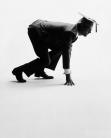Forms of Participles
Forms of Participles :
Verbs have three participles - the present, the past and the perfect.
The present participle ends in ING. It usually describes an action as taking place at the same time with some other action.
1. Tom came sauntering up the path.
2. The beggar shambled down the steps, grumbling.
3. Reaching for the flower, I lost my balance.
The present participle often refers to time preceding that denoted by the predicate verb.
1. Rising from his chair, he bowed. [That is, when he had risen.]
2. Learning that your brother was in trouble, I hastened to his aid.
The vpast participle is always associated with the idea of past time or completed action.
The past participle of a weak verb has the same form as the past tense.
Present Tense……..Past Tense……..Past Participle
I mend chairs. ……..I mended the chairs. ……..The chairs are mended.
I sweep the rooms……...I swept the rooms. ……..The rooms are swept.
I seek treasure. ……..I sought treasure. ……..Treasure is sought.
I lose money. ……..I lost money. ……..The money is lost.
The past participle of strong verbs shows a change from the vowel of the present tense.
All strong verbs had originally the ending en (n) in the past participle, but this ending has been lost in many verbs.
Present Tense. ……..Past Tense. ……..Past Participle
He speaks. . ……..He spoke. . …….. (He has) spoken.
He draws. ……..He drew. . ……..(He has) drawn.
He sings. . ……..He sang. . ……..(He has) sung.
He wins. . ……..He won. . ……..(He has) won.
The forms show great variety and must be learned by practice.
The perfect participle is made by prefixing HAVING to the past participle.
1. Having mended the watch, I sent it to the owner.
2. Having lost his money, James was forced to walk home.
The present participle is used in forming the progressive verb-phrases.
The past participle is used in forming the complete tenses and the passive voice.
Forms of Participles :
Forms of Participles To HOME PAGE

Related Links : Forms of Participles